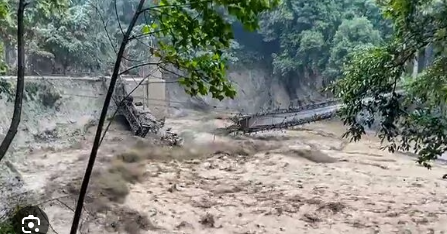Manas Dasgupta
NEW DELHI, Oct 6: The death toll in the flash floods in Sikkim went up to 40 including seven army personnel with at least 103 people are still missing as the bodies flown down the swollen Teesta river were being found way down in north Bengal and even Bangladesh.
The Army is carrying out extensive rescue operations for thousands stranded in the deluge even as the Centre released advance instalments of State Disaster Response Fund (SDRF) and constituted an inter-ministerial technical team to assess the damage caused by the flash floods.
Officials said. Downstream search-and-rescue teams recovered more bodies overnight as the waters cut a swathe through the countryside towards the Bay of Bengal.
“Around 3,000 people are stranded in Lachen and Lachung. 3,150 people who have gone there on motorcycles are also stuck due to the floods. We will evacuate all with helicopters of Army and Air Force,” said Sikkim Chief Secretary Vijay Bhushan Pathak. Authorities have urged tourists to delay their travel with the possibility of another glacial lake burst.
A total of 103 people, including 15 Army soldiers, remained missing after a cloudburst over Lhonak Lake in North Sikkim in the early hours of Wednesday triggered the flash flood. The flood has affected normal life in the districts of Bankura, Howrah, Hooghly, Paschim Medinipur and Purulia in West Bengal as well. At the moment, 9,215 people have taken shelter in 191 relief camps in the northern and southern districts of Bengal.
The Union Home Minister Amit Shah has approved release of both instalments of Central share of SDRF to Sikkim amounting to ₹44.80 crore in advance, for the year 2023-24, to help the State in providing relief measures to people affected by the flash floods.
Army and NDRF teams worked their way through slushy earth and fast flowing water in the Teesta river basin and downstream north Bengal for the third day in search of those who were swept away and are still missing, officials said.
To make an assessment of damages caused due to a glacial lake outburst flood (GLOF), cloud burst and flash floods, the Ministry of Home Affairs has constituted an Inter-Ministerial Central Team (IMCT), which will visit the affected areas of the State shortly, the ministry announced. Based on the assessment of IMCT, further additional Central assistance from National Disaster Response Fund (NDRF) to Sikkim will be approved, as per laid down procedure.
Sikkim Chief Minister Prem Singh Tamang said the destruction of the Chungthang Dam on Wednesday was due to the “inferior construction” by previous state governments.
“Dam is fully damaged… washed out. Disaster in the lower belt is because of this. Yes… there was a cloudburst and the Lhonak Lake burst… but, because of inferior and sub-standard construction by previous government, the dam broke and even more floods hit Lower Sikkim with violence,” Mr Tamang said.
A glacial lake burst in the upper reaches of Sikkim triggered the flash floods and a glacial lake outburst, releasing water from Chungthang Dam and drastically increasing the water level of the Teesta River Wednesday morning, causing widespread devastation in the Himalayan state.
The government-owned hydropower company NHPC is doing everything it can to quickly reopen its hydropower plants, as the ministry watches closely what is happening in the Teesta basin after the flash floods. The Power Ministry said it would conduct a thorough assessment of the damage to hydropower projects in Sikkim once the floodwaters recede. Flash floods on the night of October 3-4 submerged or washed away all bridges downstream of the Teesta-V hydropower station, up to Tarkhola and Pamphok.
Flash floods destroyed 14 bridges in Sikkim, including eight in Mangan district, two in Namchi, and one in Gangtok. The floods also damaged water pipelines, sewage lines, and 277 houses in four districts. NDRF platoons in North Sikkim are on standby to evacuate local residents.
Climate scientists warn that similar disasters will become an increasing danger across the Himalayas amid rise in global temperatures. “None of the scenarios are good,” they added. “Even the most modest scenario tells us that… similar glacial lake outbursts flood events are very likely.”

